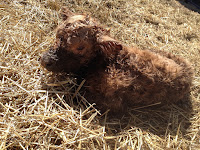"Mark, what is tha...?
Is that a...?
Oh my Go...!
It's a calf!"
Walking closer to get a better look, I realized that this pig-sized and pig-nosed animal, completely submerged in the mud and muck of the cattle shed and wedged under the gate was not an escaped pig but, in fact, a newborn calf. Mark rushed in and carried the calf to drier ground. I ran for towels and buckets of warm water. Mama was nowhere to be seen. After cleaning up the calf the rest of the herd became curious and every one came to sniff and check it out. We determined that mama was Maudine. This was her first calf and she didn't seem to have any interest in tending to him. Covered in mud and manure, its nostrils packed with the same, perhaps the scents that would normally trigger the mother/calf instincts were still dormant.

The calf grew well and we named her Lola. All of the year's females would have L names but Lola ended up being our only girl, the only calf from the season who would be sold as a breeder rather than raised - unnamed - for beef. One day, standing in the pasture watching the herd, one of us (I don't remember who) noticed that there was something very wrong with Lola.
Lola had balls!
By this time Lola was Lola and he kept his name. Lola was one of the "Naughty Boys". Every year there are a few who have no respect for fences. They get out and wander the property, sometimes wander down the road, at times even visiting the neighbors. For as much trouble as they cause - walking through my gardens and causing strangers to stop in at all times of the day and night to let us know "your cows are out" - these naughty ones become our favorites. The naughty ones are the ones we interact with daily. They curiously check out the bonfire, drink from the bird bath, and munch the long grasses that border the yard as we go about business as usual. Generally more socialized and friendly than the rest of the herd, they are especially calm and easy to work with. They trust us and we trust them. It doesn't take long for them to learn the routine and when we tell them it's time to go back inside the fence they amble down the driveway and through the gate easily. At times, we just let them stay out and wander as long as they are safe on our property and not close to the road. Some of my best photos are of these naughty ones because there is open landscape in the backround, no fences.
I always try to be there when the butcher comes. As difficult as it is, it is important for me to be there, even more so this time. If you are cringing and withdrawing at this point, be assured. Our butcher is quick. The animals are not frightened or in pain. One instant they are grazing peacefully in their home pasture, the next they are gone. I have watched before. It is always difficult. But it's important. Lola's life, like the lives of all pasture raised livestock, was important. He fed in the pastures, encouraging deep rooting of the pasture grasses, which anchor the topsoil and decompose to provide nutrients to the soil. His hooves tilled the earth with each step. As he walked he fertilized the land. With his death this one cow will provide enough beef for a full year for our family and friends.
This is the point where I want to go off on a pre-emptive rant about the impact of vegetarianism on the environment but that's not what this is about. We all have the right to believe as we will and we can all find plenty of Google-searched charts and studies to back us up. Instead, I will allow myself to feel the sadness of their deaths of Lola and the other two steers. I will recognize the importance of their part in a much bigger picture and I will give thanks and gratitude for their lives.






No comments:
Post a Comment